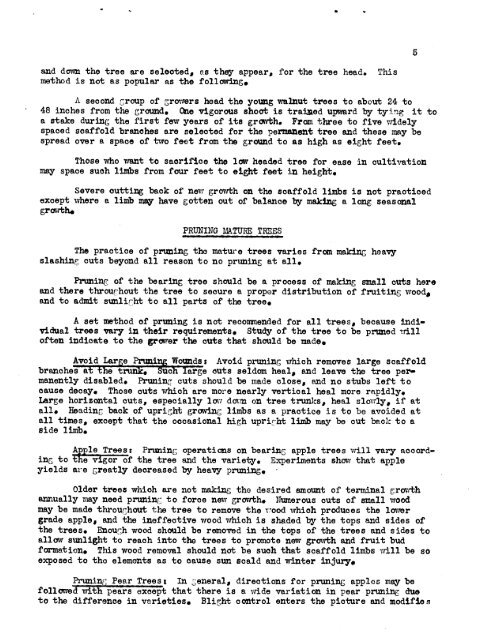Pruning suggestions for fruit trees.pdf
Pruning suggestions for fruit trees.pdf
Pruning suggestions for fruit trees.pdf
You also want an ePaper? Increase the reach of your titles
YUMPU automatically turns print PDFs into web optimized ePapers that Google loves.
and down the tree are selected, as they appear, <strong>for</strong> the tree head. This<br />
method is not as popular as the following,<br />
A second group of growers head the young walnut <strong>trees</strong> to about 24 to<br />
48 inches from the ground. One vigorous shoot is tratod upward by tying it to<br />
a stake during the first few years of its growth. From three to five widely<br />
spaced scaffold brenohes are selected <strong>for</strong> the permanent tree end these may be<br />
spread over a space of two feet from the ground to as high as eight feet.<br />
Those who want to sacrifice the low headed tree <strong>for</strong> ease in cultivation<br />
may space such limbs from four feet to eight feet in heighi.<br />
Severe cutting back of new growth on the scaffold limbs is not practiced<br />
except where a limb may have gotten out of balance by making a long seasonal<br />
growth.<br />
PRUNING MATUPE TREES<br />
The practice of pruning the mature <strong>trees</strong> varies from making heavy<br />
slashing outs beyond all reason to no pruning at all,<br />
<strong>Pruning</strong> of the bearing tree should be a process of making small cuts here<br />
and there throurhout the tree to secure a proper distribution of <strong>fruit</strong>ing wood9<br />
and to admit sinflirht to all parts of the tree,<br />
A set method of pruning is not reoozmnended <strong>for</strong> all <strong>trees</strong>, because individual<br />
<strong>trees</strong> vary in their requirements. Study of' the tree to be primed will<br />
often indicate to the grower the outs that should be made.<br />
Avoid Large Pruniig Wounds: Avoid pruning which removes large scaffold<br />
branches at the trunk, uo1i large cuts seldom heal, and leave the tree permanently<br />
disabled, <strong>Pruning</strong> cuts should be made close, and no stubs left to<br />
cause decay. Those cuts which are more nearly vertical heal more rapidly.<br />
Large horizontal outs, especially low don on tree trunks, heal slowly, if at<br />
all. Eeading back of upright growing limbs as a practice is to be avoided at<br />
all times, except that the occasional high uprirht lint may be cut back to a<br />
side limb.<br />
Apple Trees: <strong>Pruning</strong> operations on bearing apple <strong>trees</strong> will vary according<br />
to the vigor of the tree and the variety. Experiments show that apple<br />
yields are greatly decreased by heavy pruning.<br />
Older <strong>trees</strong> which are not making the desired amount of terminal growth<br />
annually may need pruning to <strong>for</strong>ce new growth. Numerous outs of small wood<br />
may be made thromliout the tree to remove the rood which produces the lower<br />
grade apple, and the ineffective wood which is shaded by the tops and sides of<br />
the <strong>trees</strong>. Enough wood should be removed in the tops of the <strong>trees</strong> and sides to<br />
allow sunlight to reach into the <strong>trees</strong> to promote new growth and <strong>fruit</strong> bud<br />
<strong>for</strong>mation, This wood removal should not be such that scaffold limbs will be so<br />
exposed to the elements as to cause sun scald and winter injury.<br />
<strong>Pruning</strong> Pear Trees: In general, directions <strong>for</strong> pruning apples may be<br />
follcwed with pers except that there is a wide variation in pear pruning due<br />
to the difference in varieties. Blight control enters the picture and modifies<br />
5
















